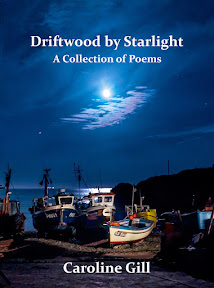I was on the 'government shielded' list during lockdown so was confined to the house and garden for almost thirteen weeks. Time for most of us has been a strange commodity during this pandemic, time and most other things, too. There have been spells when the hours have raced by, but each day has gone at its own, often unpredictable, pace. The wave for the NHS and key-workers was one of the activities that punctuated my week: we waved to our neighbours after the clap and it was usually the only time I made face-to-face contact with human beings other than my husband. Nearly all other human interactions were by telephone, the internet or Zoom, and this was the case for many of us.
Most of us, I think, felt the waves of motivation ebb and flow at times during those strict months of lockdown. Early on I decided to enrol on one of the Poetry Kit courses. It lasted three weeks and was conducted via email and listserve. It gave me set tasks to do, excellent feedback from the tutor, Jim Bennett, and a group of fellow students with whom I was able to interact. At the end of the three weeks I felt a sense of achievement and enrolled on a second course, this time on poetry that engaged with the natural world. Once again, it was an extremely positive experience and, at times, a steep learning curve.
In addition to my own writing, I have felt a strong urge to offer something 'poetical', however small, to others during this difficult time. I was invited to judge a local poetry competition on the theme of 'key-workers'. I have long been persuaded that it's not what you say but how you say it that counts, and that short poems, even very short poems, can be powerful. They tend to be less daunting for new or would-be poets to write than, for example, an epic or sestina. And yet they require focus, craft and poise if they are to spin their magic. With this thought in mind, coupled with the assumption that if I was looking for chinks of light in a bleak situation, others were probably feeling the same, I started a blog for 5-line poems, written in response to a fortnightly photo prompt. The blog, The Glow of Emerald Light, can be found here. Anyone who was 18 or over was invited to join in the challenges.
I had a few of my own poems accepted and/or published during this spell. One came out in Reach Poetry (Indigo Dreams) and another, a villanelle, will appear in Locked Down, the PoetrySpace anthology edited by Susan J. Sims. Another took 2nd Place (Category A) in the Petrarchan Sonnet Contest for Metverse Muse, an international poetry journal published by Dr. H. Tulsi in India. A couple of other poems were also published in the journal, including one on the Fritillary butterfly in the picture above, which we saw some years ago on the iconic path to Hallaig on the Inner Hebridean island of Raasay.
For several years now I have teamed up with an artist (not always the same artist) with a view to submitting work to the annual Immagine e Poesia online anthology, created by Lidia Chiarelli from Italy and edited this year by Huguette Bertrand from Canada. This year I collaborated once again with South Korean artist, Jongo Park, who supplied one of his artworks, leaving me to write a poetic response. I enjoy these international collaborations. You can read the anthology via this link (or via this one).
The writing and reading of poetry go hand in hand, and the books I have enjoyed during lockdown include Forest, moor or less by Ronnie Goodyer and Dawn Bauling (IDP), Throat of Hawthorn by Carl Griffin (also IDP), The Craft edited by Rishi Dastidar (Nine Arches) and The Haiku Handbook by William J. Higginson and Jane Reichhold ( Kodansha International). We have also enjoyed re-watching the Michael Wood series, In Search of Shakespeare.
It seems strange to be posting this summary of my lockdown poetry activities just as Covid cases start to soar again, but I hope you will all keep safe as we continue to navigate these stormy waters.








No comments:
Post a Comment